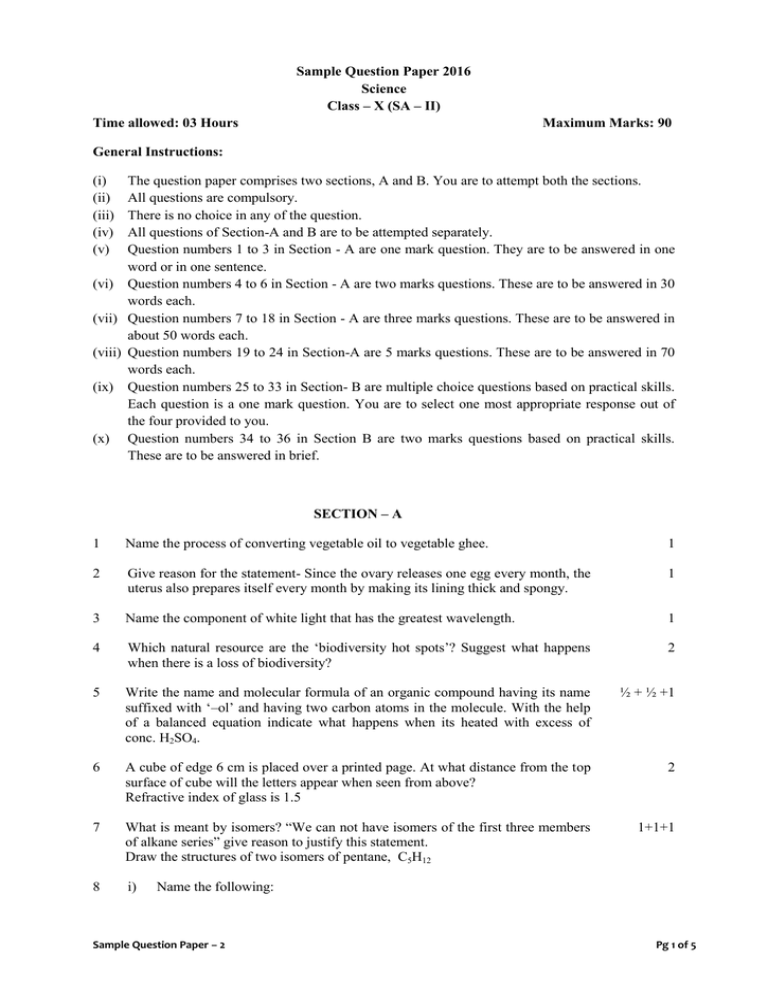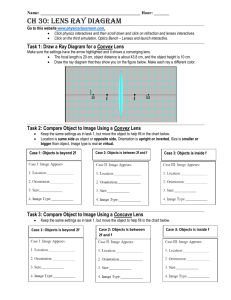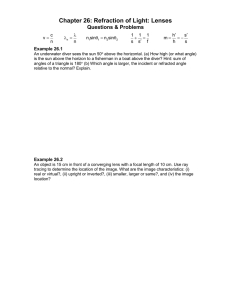Sample Question Paper 2016 Science Class – X (SA – II) Time
advertisement

Sample Question Paper 2016 Science Class – X (SA – II) Time allowed: 03 Hours Maximum Marks: 90 General Instructions: (i) (ii) (iii) (iv) (v) The question paper comprises two sections, A and B. You are to attempt both the sections. All questions are compulsory. There is no choice in any of the question. All questions of Section-A and B are to be attempted separately. Question numbers 1 to 3 in Section - A are one mark question. They are to be answered in one word or in one sentence. (vi) Question numbers 4 to 6 in Section - A are two marks questions. These are to be answered in 30 words each. (vii) Question numbers 7 to 18 in Section - A are three marks questions. These are to be answered in about 50 words each. (viii) Question numbers 19 to 24 in Section-A are 5 marks questions. These are to be answered in 70 words each. (ix) Question numbers 25 to 33 in Section- B are multiple choice questions based on practical skills. Each question is a one mark question. You are to select one most appropriate response out of the four provided to you. (x) Question numbers 34 to 36 in Section B are two marks questions based on practical skills. These are to be answered in brief. SECTION – A 1 Name the process of converting vegetable oil to vegetable ghee. 1 2 Give reason for the statement- Since the ovary releases one egg every month, the uterus also prepares itself every month by making its lining thick and spongy. 1 3 Name the component of white light that has the greatest wavelength. 1 4 Which natural resource are the „biodiversity hot spots‟? Suggest what happens when there is a loss of biodiversity? 2 5 Write the name and molecular formula of an organic compound having its name suffixed with „–ol‟ and having two carbon atoms in the molecule. With the help of a balanced equation indicate what happens when its heated with excess of conc. H2SO4. ½ + ½ +1 6 A cube of edge 6 cm is placed over a printed page. At what distance from the top surface of cube will the letters appear when seen from above? Refractive index of glass is 1.5 2 7 What is meant by isomers? “We can not have isomers of the first three members of alkane series” give reason to justify this statement. Draw the structures of two isomers of pentane, C5H12 1+1+1 8 i) Name the following: Sample Question Paper – 2 Pg 1 of 5 a) Third member of aldehyde series b) Second member of carboxylic series ii) 1 1 Write the IUPAC name of the following: CH 3 a) | CH 3 C CH 3 ½ | CH 3 b) ½ 9 Four elements A, B, C and D have atomic numbers 12, 13, 14 and 15 respectively. Answer the following questions giving reasons i) What is the number of valence electrons and valency of D? ii) Which of them will have largest atomic radii? iii) Which of these elements will form the most basic oxide? 10 Differentiate between combustion and oxidation reactions of ethanol. 3 11 In a germinating seed, which parts are known as future shoot and future root? Mention the function of cotyledon. 3 12 What is placenta? Write any two major functions of placenta. 3 13 „Different species use different strategies to determine sex of a newborn individual. It can be environmental cues or genetically determined‟. Explain the statement by giving example for each strategy. 3 14 A 2 cm high object is placed at a distance of 32 cm from a concave mirror. The image is real, inverted and 3 cm in size. Find the focal length of the mirror and the position where the image is formed? 3 15 A child while playing with his father‟s spectacles burnt a hole in a piece of paper by focusing a small image of the sun on it. (i) What defect of vision his father is suffering from? (ii) Write two causes for this defect? (iii) Draw a ray diagram to show image formation by the defective eye? (iv) Draw a ray diagram showing corrected eye using proper lens. 3 16 Explain the formation of rainbow in the sky with the help of a diagram. List the three phenomena involved in proper sequence. 3 17 Which types of people are benefited from the development of different resources? Why do we need to use the resources carefully? 3 18 Write any three characteristics of a food chain. Dharmesh always treated the chemical effluent before disposing it in the water body. Mention any three moral values possessed by Dharmesh. 3 19 In the following table. Six elements A, B, C, D, E and F of the modern periodic table with atomic numbers 3 to 18 are given: 1+1+1+1+1 Sample Question Paper – 2 1+1+1 Pg 2 of 5 3 A 11 B a) b) c) d) e) 4 5 6 7 12 C 13 14 D 15 8 E 16 9 17 F 10 G 18 Which of these is i) Noble gas ii) halogen Which of these is the most active metal in 3rd period? Identify the most electronegative element in the third period. In the compound between B and F what type of bond will be formed? What would be the nature of oxide formed by C? 20 A. Draw a longitudinal section of a flower and label the following parts – a) Part that develops into a fruit b) Part that produces pollen grain c) Part that transfers male gametes d) Part that is sticky to trap B. Name the parts labeled A, B, C, D in the diagram given below: 5 21 A. How does speciation take place? B. Define the term GENE. C. The gene for red hair is recessive to the gene for black hair. What will be the hair colour of a child if he inherits a gene for red colour from his mother and a gene for black hair from his father? Express with the help of flow chart. 5 22 A. Mention any two point of difference between acquired and inherited traits. B. If the tail of a mouse is cut for twenty one generations, will the tail occur in the twenty second generation of that mouse? Give reason to support your answer. C. Define the term – Natural Selection. SECTION B (i) Rohit claims to have obtained an image twice the size of object with a concave lens. Is he correct? Give reason for your answer. (ii) Where should an object be placed in case of a convex lens to form an image of same size as of the object? Show with the help of ray diagram the position and the nature of the image formed. (iii) With the help of ray diagram, illustrate the change in position, nature and size of the image formed if the convex lens in case of (ii) is replaced by concave lens of same focal length. 5 (i) Which property of concave mirror is utilized for using them as shaving mirrors? (ii) Light passes through a rectangular glass slab and through a triangular glass prism. Using proper ray diagram, explain in what way does the direction of the two emergent beams differs with respect to the incident beam of light. (iii) A concave lens has a focal length of 50 cm Calculate its power. 5 23 24 Sample Question Paper – 2 5 Pg 3 of 5 25 A student is given equal amount of three samples A, B and C of water with temporary hardness. He keeps the three samples at different temperatures. A at room temperature, B at 50oC and C at 80oC. Which sample will give maximum amount of lather with soap solution? a) A b) Both B and C c) Only C d) Both A and B 1 26 Soaps are formed by alkaline hydrolysis of a) Carboxylic acids b) Esters of long chain fatty acids c) Esters of small chain d) Inorganic acids 1 27 On addition of Na2CO3 to hard water a) the foaming capacity increases b) the foaming capacity decreases c) the foaming capacity increases then decreases d) the foaming capacity decreases then increases 1 28 In finding the focal length of a distant object by concave mirror, you are required to draw the ray diagram of nature. 1 29 While performing the experiment to trace the path of a ray of light passing through a rectangular glass slab, four students labeled their ray diagrams in the manner shown below. The correct labeling has been done by students. 1 30 A convex lens forms a virtual image when an object is placed at a distance of 20cm from it. The focal length (a) f = 40 cm (b) f = 20 cm (c) f > 20 cm (d) f < 20 cm 1 Sample Question Paper – 2 Pg 4 of 5 31 In a dicot seed, the pore through which the seed absorbs water during seed germination is called a) Micropyle b) Hilum c) Funicle d) Radical 1 32 For the experiment – To prepare temporary mount of yeast to study budding process; Yeast granules are made to first grow by adding them to a) Hydrochloric acid b) Distilled water c) 10% sugar solution d) Alcohol 1 33 Two slides were shown to four students, and they labeled them as following. 1 Student I II III IV Slide A Budding in Yeast Binary fission in Amoeba Binary fission in Amoeba Budding in Amoeba Slide B Binary fusion in Amoeba Buds of Amoeba Daughter cells of Amoeba Daughter cell of Yeast The student who made the correct labeling is: a) II b) I c) IV d) III 34 With regard to turnip, carrot, sweet potato and potato, three belong to the same category. Identify those three modifications and mention whether they are homologous or analogous. Also mention the reason why the fourth modifications do not belong to the same category. 2 35 A student has to perform an experiment on tracing the path of a ray of light passing through a rectangular glass slab for three different angles of incidence. Two of his friends suggest the following options to him: (A) Draw the incident rays corresponding to 20o, 50o and 70o as angles of incidence and fix the two pins on the incident ray just 2 cm apart. (B) Draw the incident rays corresponding to 30o, 45o and 60o as the angles of incidence and fix two pins on the incident rays nearly 8 cm apart. Which is the better option he should follow? Give reason in support of your answer. A student obtained a sharp image of a lighted candle on a screen using a convex lens. Now he wants to focus a distant lamp on a far away electric pole. In which direction should the lens be move for this purpose with respect to the screen, to get a sharp image on the screen? Justify your answer. 2 36 Sample Question Paper – 2 2 Pg 5 of 5



